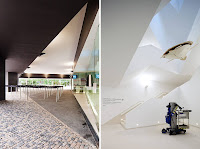The extension of the Lisbon Aquarium was a complex challenge. It entailed an intervention in a consolidated and dynamic public space. One of the aims of the project was to create a relationship between the new and existing building, which has a strong presence for the citizens of Lisbon and is currently being recommended for architectural heritage status.
The challenge was to create a building that not only is an independent architectural structure, but also an intervention that promotes a comfortable dialogue with the existing building, without overshadowing it.
The idea of leaving the surrounding public space free of any visual obstacle was one of the main premises in the search for a suitable location. The square in front of the existing building functions today in an effective and pleasant way. It is one of the most active spaces in Parque das Nações, catalysing a public thoroughfare and waiting area for the great number of visitors to the aquarium.
This project is not intended to interfere or impose itself on the existing urban space. On the contrary, it wishes to expand its character by proposing an elevated volume that serves as a roof for a new public square.
The architectural proposal is sensitive to the existing building without appearing detached or estranged.
The architectural proposal is sensitive to the existing building without appearing detached or estranged.
A slightly inclined floor grounds the project by avoiding substantial changes to the existing building, creating a stimulating dialect between the projected construction by Peter Chermayeff in 1998 and the new building.
The resulting building is contained within an irregular prism that joins the existing building as a counterpoint, volumetrically complementing the original aquarium. The new and existing buildings are connected by the main circulation slopes, which allow a dialogue and flow between the two main structures.
The east and west facades have the closest relationship with the square and surrounding public space, maintaining the geometry and alignments of the existing building.
The new building is now the entrance to the Lisbon Aquarium, where the circulation spaces occupy over 1/3 of the buildings total area. The stairs are an essential architectural element with a strong presence in the lobby, a central space with triple head height.
The new building houses a temporary exhibitions room, auditorium and public services that connect through a narrow bridge to access the lobby of the Lisbon Aquarium. The resulting passage provides a single and unique moment of connection between the two architectural interventions.
A recurrent theme in investigative practice, which also exists here, is the pre-occupation of creating architecture that can combines aesthetic demands with good sustainable performance. The formal solution of the building’s façade is a response to bioclimatic issues, with opened and closed elements allowing for passive ventilation and solar shading.
Location: Lisbon, Portugal
Architect: Campos Costa Arquitectos
Project Team: Pedro Campos Costa, Marta Onofre, Ivan Teixeira, Ana Mendes, Pedro Campos Costa, Duarte Santo, Mário Ferreira, Francisco Lemos, Marta Onofre, Alessia Allegri e Daniela Figueiredo
Consultants: Countant Aquariums
Structural engineers: Betar , estudos e projectos de estabilidade
Services and electrical Engineers: EPPE, estudo prévio
Mechanical engineers: Promee
Acoustic: Dblab
Construction Survey: Escala Digital
Model: MODELAB Marco Galofaro
3d Renderings: 4+Arquitectos
Client: Parque expo SA and Lisbon Oceanário, SA
Photos:Daniel Malhão, Radek Bruneck


















